C U R R I C U L U M M A T E R I A L S
|
Laura Crane Lewis
Overview
Main Ideas
Material culture studies is not so much
an academic field as a subject where many
different academic fields come together.
Material culture historians borrow from the
expertise of historians, art historians, geographers, archaeologists, anthropologists,
psychologists, and sociologists. When those
different fields come together, their combined research can illuminate the complicated interactions between people and
things. Yet the roots of material culture
studies are not complicated but lie in the
simple, everyday objects that clutter
people's lives—from books to cities.
Museums celebrate the power of those
ordinary objects to tell a story about who
made them and why through exhibits. It is
the job of museum experts to discover,
identify, and classify objects of material
culture and then analyze and interpret those
artifacts for the public in a cultural context.
Museum exhibits provide the visitor with a
framework for interpreting material culture
artifacts. An exhibit such as At Home in the
Heartland can offer insights into the lives
of people who have left artifacts and few,
if any, other records. By exploring material
culture artifacts from the present, the exhibit
also asks visitors to view their own lives
within a cultural and historic context.
7
Connection with the Curriculum
Material culture studies have the potential to integrate the disciplines of social studies, geography, language arts, fine arts, and
even mathematics and science for the secondary school student. The practice of material culture studies involves critical thinking,
problem-solving, and hands-on research.
The methods for studying material culture
build on a rigorous and systematic examination of the evidence that proceeds from discovery, identification, and classification of
material culture to the thoughtful analysis and
interpretation of those artifacts within a cultural context. The object or artifact becomes the
linchpin on which a student can form an
understanding of the interrelationships
between the academic disciplines, the past
and the present, and people and things.
Teaching Level
Grades 6-12
Materials for Each Student
• A copy of the narrative portion
of this article
• Activity handouts, pen or pencil, paper
• A dictionary and encyclopedia for
student use
Objectives for Each Student
• Understand the methodology that is
used in the study of material culture—
discovery, identification, classification,
analysis, and interpretation of artifacts
in a cultural context.
• Recognize the importance of primary
and secondary sources in establishing
the history of an object.
• Encourage critical thinking and problem-solving skills through the analysis
of objects.
• Demonstrate the ability to write expository materials, such as object labels.
SUGGESTIONS FOR
TEACHING THE LESSON
|
Opening the Lesson
Distribute the narrative portion of this
article, which describes the study of material
culture and examines the exhibit At Home in
the Heartland as a case study. A discussion
of the article's narrative should follow the
reading. Ask students to define material
culture in their own words. Discuss the
methods used for studying material culture
and ask students to find examples of that
process from the article. Such a discussion
might provide insight and a better understanding of the range of objects and
materials that constitute material culture.
Developing the Lesson
• This lesson may be done individually,
in small groups, or as a whole group.
• Activities can be assigned in class or
given as homework.
• In the first activity, students will analyze catalog cuts from the 1890s to
1920s as they answer a series of
questions designed to help them
organize the visual and written
material so that they can begin to
analyze the objects.
• In the second activity, students will
read the object label that was written
for each of the catalog cuts. Students
must determine what information came
from the catalog description and what
information came from other sources.
Encourage students to think about the
variety of sources that could have
been used by the curator—from the
actual object to history books.
• The third activity builds on Activities 1
and 2. Students are given the photo of
an object, its donor history, and museum catalog record. Using these three
sources students are asked to develop
their own object label. Encourage students to move beyond a description of
the object to an interpretation of how
the object was used and its significance as a symbol of status. Students
might want to consult other sources to
learn more about 1860s society.
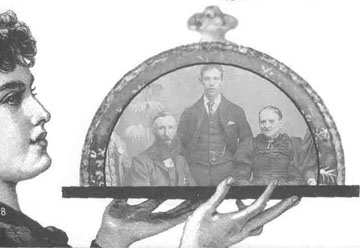
8
Concluding the Lesson
• Grade the students' final object labels.
• Review and summarize the method of
material culture studies.
• Discuss where to find sources to help
establish the history and cultural context of a material culture artifact.
Extending the Lesson
- Writing Object Labels
A. The teacher provides objects, and
students write object labels. The
objects could pertain to a certain
historical era or literary theme
depending on the class. For example, if your class is studying immigration, you might bring in objects
from other countries that can be
identified with an immigrant group.
Students might use history books,
atlases, and encyclopedias to find
out more about an object's country
of origin.
B. The local history museum provides
objects, and the students write
object labels. If you have a local
history museum or historical society
in your area, contact it in advance
about the possibility of bringing a
group of students to the museum
to view objects from their collections. Students can examine the
objects and record their observations through notes, drawings, or
photographs. In the classroom,
students can write the object labels
after they have studied their notes
or consulted books for additional
information.
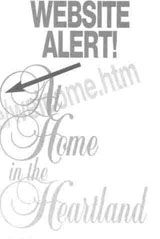
|
C. The students provide objects and
work in small groups or teams to
write object labels. Select a group
of students to bring in objects.
Students can select the objects
according to their own criteria, or
the class can choose a theme
around which to work. Students
bring in objects. Split the class into
groups of 2 or 3 students. Each
group selects an object and creates
an object label. Encourage students
to use secondary sources in writing
their labels. Have them turn in a
bibliography of sources with their
finished labels.
- Class Exhibit
Build from the above activity. Have
your class create an exhibit. The exhibit
can consist of several objects or just a few.
As a class, select a theme for the exhibit.
Based on the theme, students will develop
a storyline for the exhibit, an overall title
for the exhibit (as well as secondary titles
if needed), wall labels, and object labels.
Encourage students to think as much about
the overall presentation of the objects as
about the content of written materials.
Depending on how elaborate the exhibit
becomes, you may want to display it in a
public space within your school building
instead of your classroom. If students
decide to create an exhibit about their own
families and communities, you may want
to involve parents and grandparents as
sources of information or as the subjects
of oral histories.
- Visit a Local History Museum
Visit a local history museum and
critique an exhibit: Is there a central theme
or story? How are the labels organized?
Are there aspects of the exhibit that
students would change? Help students
measure their own learning through a
K-W-L anticipation activity using the theme
of the exhibit or museum you will be visiting.
On the chalkboard or overhead projector,
record what they know in a column headed
K. In a second column, headed W, have
students indicate things they "want to know"
about the exhibit theme. A third column,
headed L, is left for students to record
what they have learned from the exhibit.
- Visit the At Home in the Heartland
Online Website
If you have an Internet connection and
a World Wide Web browser (Netscape or
Microsoft Explorer), you can access dozens
of activities that have been developed for
your age group from the exhibit At Home in
the Heartland. The site can be accessed at: http://www.museum.state.il.us/exhibits/athome/welcome.htm
Assessing the Lesson
All of the activities are designed to
require student products. Those can then
be assessed to determine student understanding. They can also be used to
evaluate student skill levels in researching,
writing, speaking, and creativity. Students
can judge each other's products as well.
9

These questions are commonly asked in identifying objects. Answer as many questions as
you can with the information provided in the illustrations (catalog cuts) below.
|
What is it used for?
Who made it?
When was it made?
Where was it made?
What is it made of?
What is the style, type, or pattern?
How was it made?
Who was it made for?
What size is it?
How much does it weigh?
How much did it cost?
Where was it purchased?
|
Source: Montgomery
Ward Catalog, 1895
|
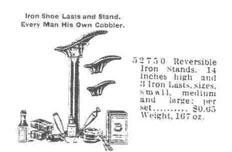
|
Source: Sears, Roebuck and Co.
Catalog, 1919
|
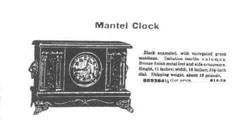
|
Source: Montgomery
Ward Catalog, 1895
|
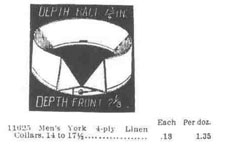
|
|
10

Highlight or underline any information that you think came from sources other than the catalog cuts in Activity 1. What might those sources have been?
SHOE LASTS AND STAND, ca. 1394
Eclipse model
Iron
A set of iron shoes lasts, used for making or repairing shoes, sold for 65 cents in the
Montgomery Ward catalog of 1895. Wooden lasts were much less durable and sold for only
30 cents. Catalog advertising for a set of lasts read, "No family should be without one as it
saves time and money." They were sold along with items such as a cobbler's hammer,
sewing awl, leather, and oak soles. These lasts belonged to Pancratz Boll, a shoemaker who
immigrated from Germany to settle in Greenville, Illinois, in 1856.
Gift of Mr. and Mrs. Howard Riser, Springfield, Illinois (1989.28.4)
MANTEL CLOCK, ca. 1919
Made for Sears, Roebuck and Co., Chicago, Illinois, by Waterbury Clock Co., Waterbury,
Connecticut
Gilt, marbleized, and black lacquered wood; bronzed metal
Duncan Bennett of Rockford, Illinois, ordered this clock to give to his son Andrew P.
Bennett as a wedding gift. Over the years he gave a similar clock to each of his children
when they married. This clock had to be wound every eight days and would strike each half
hour. The black enamel of the clock's case and the variegated green of its columns were
highly polished in imitation of fine marble. A similar clock sold in the fall 1919 Sears catalogue for $10.29.
Gift of the Andrew Bennett Family, Peoria, Illinois (1990.1.1 a)
WING COLLARS, ca 1904
Made by Cluett, Peabody & Company, Inc.
Linen, celluloid
Because laundry was such an ordeal before plumbing and washing machines, shirts
were worn for several days to a week. Collars and cuffs were detachable so they could be
changed more frequently. These collars were worn by P. W. Wemple of Waverly, Illinois.
Similar collars were 13 cents each or $1.35 per dozen in the Montgomery Ward catalog of
1895.
Gift of Ann Wemple Henry, Jr., Flossmoor, Illinois (1979.28.2)
11

Donor History
745/072
Walnut secretary. (1865) Maker: Ernst F. Gehlman,
cabinetmaker and builder, who came from Germany
to Sangamon County ca. 1846.
Ref: Past and Present Springfield, Illinois and Sangamon
County, Illinois- p. 1171-2; Sangamon County Atlas, p. 79.
Affidavit attached.
Made for the Wellington Birthier Huffaker mansion, "Fancy
Point," near New Berlin, Sangamon County. Secretary
made after the mansion's completion in 1865. (Huffaker
built the mansion and many Springfield homes.) Original
price $200.00 - Constructed in two sections: Glass doors
and shelves above, drawers below with center pull-out for
writing. Cubby-hole cabinet below with secret drawers.
|
|
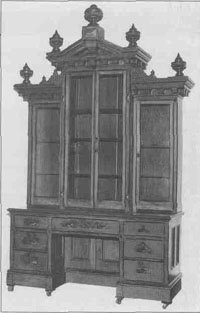
|
|
Museum Catalog Record
OBJ: NAME: Secretary ACC:NO 1972.2
CLASSIFICATION: Furniture CAT: NO 745072
MAKER: Gehlman, Ernst F.
DATE: 1865
COUNTRY: USA DESIGNER STATE: IL CITY: Springfield
TECHNIQUE:
MATERIALS: Walnut COLOR:
STYLE, TYPE, PATTERN: Renaissance Revival
SIZE: 118"hx76"wx26l/2"d
DESCRIPTION: Walnut secretary desk with bookcase top, 4 glass doors, heavy pedimented top, center drawer
and 3 drawers on each side of bottom desk. Made for the Wellington Birthier Huffaker mansion
in New Berlin for $200. Center drawer pulls out for writing.
ASSOCIATION: Huffaker, Wellington Birthier
SOURCE: Huffaker, James C. Family
SOURCE: ST 114 Lake Glen Drive
SOURCE: LOC Carson City, Nevada GIFT, PURCHASE.LOAN: G
DATE: ACQ 9-1972 NEG: No SLIDE: No
COND: CODE G
LOCATION ex: AT HOME CONDITION: VALUE 0 VALU: DATE
DATE: ENTRY 1-31-89 ENTERED BY: Jan Wass
IN EDIT CTL-R BACK
CTL-C FORWARD CTL-W RETURN TO . 4756
|
Photo courtesy of Illinois State Museum, photograph by Marlin Roos
12

Object Label
Title:
Made by:
Made of:
Style:
Interpretation:
Donor:
Click Here to return to the Article
13
|

